Archive for October, 2013
Saturday, October 12th, 2013
 Ecological consultant David Paul with a koala found in the Leard State Forest
[Source: Photo by Tania Marshall, Front Line Action on Coal,
^http://frontlineaction.wordpress.com/] Ecological consultant David Paul with a koala found in the Leard State Forest
[Source: Photo by Tania Marshall, Front Line Action on Coal,
^http://frontlineaction.wordpress.com/]
.
Environmentalists are urging the New South Wales and Australian governments to save the Leard State Forest. They are concerned about the catastrophic impact of major mining expansion on an isolated and vulnerable koala colony in its natural habitat within the Leard State Forest.
The Leard State Forest is situated near Maules Creek within the Namoi River catchment about 10km north-east of the township of Boggabri on the North West Slopes of New South Wales, about 500km nor’-nor’-west of Sydney.
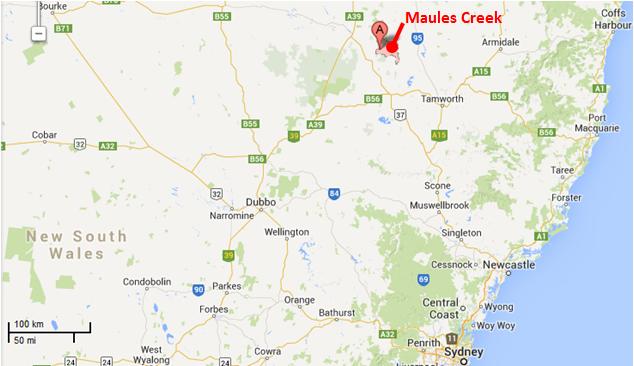 Maules Creek Mine location map
[Source: Google Maps] Maules Creek Mine location map
[Source: Google Maps]
.
The nearby town of Boggabri lies on the Namoi River, a major perennial river and floodplain within the Murray-Darling Basin. The landscape is naturally subjected to infrequent seasonal rains and widespread flooding.
.
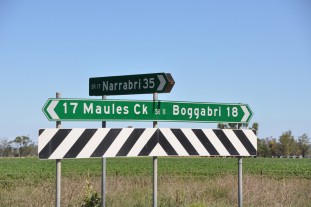 . .
The native vegetation has been naturally dominated by Box-Gum Woodland ecological communities featuring the endemic species of White Box, Pilliga Box and Bimble Box. These provide vital habitat for numerous woodland bird and microbat species and a small community of Koalas.
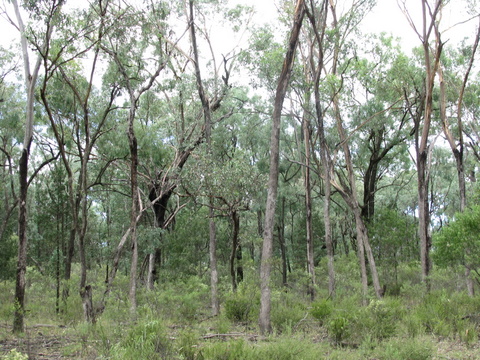 The Leard State Forest
An isolated remnant box woodland The Leard State Forest
An isolated remnant box woodland
.
The region was originally the Aboriginal land of the Kamilaroi people and their ‘place of many creeks‘. However, two hundred and twenty five years of colonial pastoral settlement and associated widespread deforestation has seen the region denuded of most native vegetation historically for sheep and wheat; and more recently for irrigated cropping, particularly water thirsty cotton.
.
 Box Woodland decimated for industrial scale cotton
The farming model is entirely artificially dependent river-diverted irrigation for export produce.
[Source: Promotional tourism advertisement by the NSW Government,
^http://www.visitnsw.com/destinations/country-nsw/moree-and-narrabri-area/gallery] Box Woodland decimated for industrial scale cotton
The farming model is entirely artificially dependent river-diverted irrigation for export produce.
[Source: Promotional tourism advertisement by the NSW Government,
^http://www.visitnsw.com/destinations/country-nsw/moree-and-narrabri-area/gallery]
.
Native habitat has been sadly reduced to a few isolated islands of land set aside as ‘State Forests’. These include the Pilliga Forest, the largest remnant temperate forest in Eastern Australia, as well as Jacks Creek, Plagyan, Rusden and Leard State Forests, as well as the rugged Mount Kaputar National Park.
Leard State Forest includes the most extensive and intact stands of the nationally listed and critically endangered Box-Gum Woodland remaining on the Australian continent and is home to nearly 400 native species of plants and animals, and includes habitat for 34 threatened species and several endangered ecological communities.
.
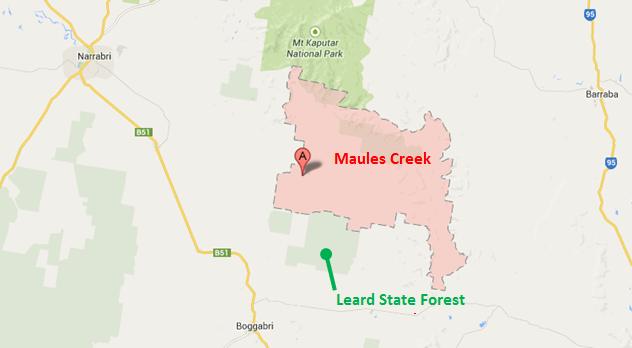 Leard State Forest location map
[Source: Google Maps] Leard State Forest location map
[Source: Google Maps]
.
It’s believed as few as 20 koalas are left in the Leard State Forest, which is considered its primary habitat. The primary food source for the koalas is thought to be the Pilliga Box, Red Gums and Yellow Boxes. This Koala population is very fragile and could be significantly impacted on by the future mining plans.
Ecological consultant David Paul:
“If they are part of the same population as the Pilliga koala, then Leard is a very important area for allowing the dispersal of these animals in an east west direction. Leard Forest is a stepping stone between habitat in the Pilliga and to the east and south. While there are not many koalas there it’s a very important area to allow the dispersal of koalas in the region.”
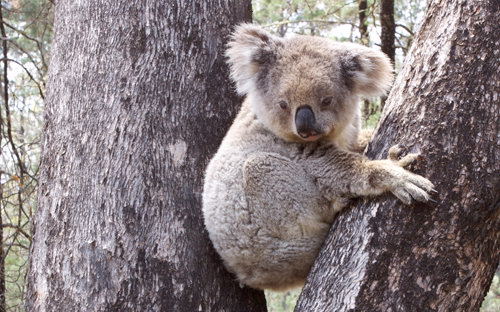 Koala in Leard State Forest
[Source: Photo by Tania Marshall, Front Line Action on Coal,
^http://frontlineaction.wordpress.com/] Koala in Leard State Forest
[Source: Photo by Tania Marshall, Front Line Action on Coal,
^http://frontlineaction.wordpress.com/]
.
.
Whitehaven Coal mining expansion into the Leard State Forest
.
<< Approval has been given for one of the biggest open-cut coal mines in the world in the state’s north-east. Whitehaven’s Maules Creek Project, near the Leard State Forest, will extract 12 million tonnes of raw coal a year.
If given the final go ahead from the Federal Government, Whitehaven expects production to start mid-2013, with operations predicted to last around 30 years.
Managing director Tony Haggarty:
“The mine will be good for the region economically and good for the state. It’s one of the best coal developments in the world. It’s a large reserve, it’s very good quality. It’s the sort of coal that is in demand in the market place, and because the reserve is large and because it has a long life, there will be a significant area of land involved.”
.
But Federal Environment Minister Tony Burke says the project will now face Commonwealth scrutiny. It will examine the mine’s potential impacts on the nearby critically endangered white box woodland.
An Environment Department spokeswoman says once the assessment is complete, it will go before Mr Burke who will consider the advice of the department, the Independent Expert Scientific Committee on possible water impacts, and any public comments.
Environmentalist Phil Spark:
“The planning commission’s approval is a blow to the endangered trees and animals that live in the forest. My biggest concern is that the environment has been totally undervalued. You just can’t destroy a forest and think it’s going to be compensated. It’s an endangered ecological community and it just can’t be replaced.”
The Maules Creek Project is about 18 kilometres north of Boggabri in the Gunnedah Basin. >>
.
[Source: ‘Go ahead for one of world’s largest coal mines’, 20121025, ^http://www.radioaustralia.net.au/international/2012-10-25/go-ahead-for-one-of-worlds-largest-coal-mines/1035960]
.
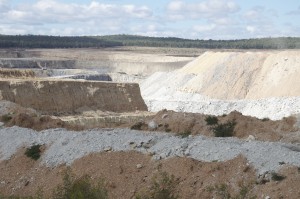 Nearby Boggabri Open Cut Coal Mine, owned by Whitehaven Coal
Saw thousands of hectares of native Box Woodland bulldozed in 2006. Nearby Boggabri Open Cut Coal Mine, owned by Whitehaven Coal
Saw thousands of hectares of native Box Woodland bulldozed in 2006.
.
Environmentalists are up in arms over a proposal to mine two thousand hectares of state forest, among it, this remnant koala habitat.
The Maules Creek Mine adjoining the Leard State Forest has received NSW government approval to expand into the forest, which will see most of the forest and its flora and fauna all but completed bulldozed into history.
Whitehaven Coal wants a new open-cut coalmine that will extract up to 13 million tonnes of coal a year to earn it $767 million. It also wants a second nearby Idemitsu Boggabri open cut mine to extract 7 million tonnes a year.
Greens Senate Candidate Cate Faehrmann:
“These approvals will literally change the face of the township of Gloucester as well as the small community of Maules Creek near Narrabri in the state’s north-west. The Maules Creek and Boggabri proposals were referred to the Federal environment minister Tony Burke because they are going to wipe out critically endangered forest which is home to many threatened species. How can any Environment Minister in their right mind approve this?
The Maules Creek coal mine alone will emit the same amount of carbon emissions each year as New Zealand during its proposed 30 year life span. This is disgraceful and it’s why communities everywhere are starting to call on the government to transition away from coal and towards a secure renewable energy future.
I have visited the site of the proposed Maules Creek coal mine recently to see the forest firsthand and saw a koala up close in the forest. Tony Burke has just approved a coal mine which will wipe out a small and vulnerable koala population
“The farmers who have been fighting coal mine proposals in Leard State Forest for years will continue to fight for the protection of their forest.”
.
Up until recently, Whitehaven Coal has been owned by multimillionnaire Nathan Tinkler. Its chief executive is Paul Flynn and one of its directors is former National Party leader Mark Vaile. In June 2013, after securing his Maule’s Creek Mine expansion approval, Tinkler sold off most of his shareholdings in Whitehaven Coal to an American profiteering investment capital firm, Farallon Funds.
Whitehaven Coal has been challenged in the courts against its proposal to mine the Leard State Forest by the Northern Inland Council for the Environment. This community based not-for-profit group has said the Federal government was wrong to approve the project. They are challenging the approval process of both the Maules Creek and nearby Idemitsu Boggabri coalmines “because of the dodgy process by which they were approved and the devastating impacts they will have”.
Whitehaven Coal chief executive Paul Flynn has insisted the court challenge to the approval of the Maules Creek mine in NSW will not stop the project and is merely a “frustrating niggle“.
Last financial year Whitehaven made a loss of $82 million.
.
[Sources: ‘Whitehaven carries on with project despite legal challenge’, 20130720, by Michael Hobbs and AAP, ^http://www.afr.com/p/national/whitehaven_carries_on_with_project_z0EwnCKbgJE1Xnrp3wJVoO; ‘Whitehaven Coal falls to $82m loss’, 20130827, by Greg Roberts, Sydney Morning Herald, ^http://news.smh.com.au/breaking-news-business/whitehaven-coal-falls-to-82m-loss-20130827-2sndo.html; ‘Tinkler sells out of Whitehaven’, 20130619, by Glenda Kwek, Sydney Morning Herald, ^http://www.smh.com.au/business/mining-and-resources/tinkler-sells-out-of-whitehaven-20130619-2ohnj.html; ‘Mining proposal puts koala habitat under threat’, 20121109, by Liv Casben, ABC media, ^http://www.abc.net.au/news/2012-11-09/mining-proposal-puts-koala-habitat-under-threat/4363234; ‘Concern for Koala’s in the Leard State Forest’, 20121112, by Kelly Fuller, ABC media, ^http://www.abc.net.au/local/audio/2012/11/12/3630754.htm; ‘Labor turns back on NSW environment’, 20130211, by Cate Faerhmann, ^http://catefaehrmann.org/tag/mining/]
.
Listen to ABC Radio interview with Ecologist David Paul in 2012:
 (Click icon and play audio on the ABC Radio website, turn up volume to listen)
[Source: ‘Concern for Koala’s in the Leard State Forest’, 20121112, radio interview by Kelly Fuller, Morning Show, ABC Radio New England NSW,
^http://www.abc.net.au/local/audio/2012/11/12/3630754.htm] (Click icon and play audio on the ABC Radio website, turn up volume to listen)
[Source: ‘Concern for Koala’s in the Leard State Forest’, 20121112, radio interview by Kelly Fuller, Morning Show, ABC Radio New England NSW,
^http://www.abc.net.au/local/audio/2012/11/12/3630754.htm]
.
.
.
Further Reading:
.
[1] Front Line Action on Coal, (a community-based environmental activist group), ^http://frontlineaction.wordpress.com/
.
[2] ‘Koala habitats in danger as bushland areas are bulldozed‘, 20121011, Sydney Morning Herald, ^http://www.smh.com.au/environment/animals/koala-habitats-in-danger-as-bushland-areas-are-bulldozed-20121011-27fjw.html
.
[3] ‘Mining proposal puts koala habitat under threat‘, 20121109, ABC News, ^http://www.abc.net.au/news/2012-11-09/mining-proposal-puts-koala-habitat-under-threat/4363234
.
[4] ‘Burke approves huge gas and coal plans‘, 20130212, by Ben Cubby, Paddy Manning, Sydney Morning Herald, ^http://www.smh.com.au/federal-politics/political-news/burke-approves-huge-gas-and-coal-plans-20130211-2e8vh.html
.
<< A clutch of big coal and coal seam gas projects, including the controversial Whitehaven mine near Narrabri in NSW, have been approved by the federal Environment Minister, Tony Burke. He signed conditional approvals for Whitehaven’s Maules Creek mine, planned for the Leard State Forest, Idemitsu’s neighbouring Boggabri coalmine expansion, and a coal seam gas development planned by AGL for Gloucester in NSW.
Together, the three resources projects would have a huge carbon footprint of 47 million tonnes of greenhouse gases a year – about 8 per cent of Australia’s total emissions – according to environmental impact assessments. Whitehaven, part-owned by embattled coal baron Nathan Tinkler, was subject to a damaging hoax when anti-coal campaigner Jonathan Moylan issued a fake press release claiming ANZ had stopped funding the project, causing a temporary drop in the miner’s share price. His protest is being investigated by the Australian Securities and Investments Commission.
The mining projects had all been approved at state level. Mr Burke’s signature was seen as the final obstacle to development.
”Of all the decisions I have ever made, this is the one where I have the least idea of whether the projects are going to go ahead,” he said. ”For all three projects there are substantial issues.”
Some of the hurdles yet to be overcome are the preservation of a ”biodiversity corridor” in the Leard Forest to allow koalas and other vulnerable animals to survive, high quality offsets to partially compensate for sections of the forest which would be cut down, and a hydrogeological survey around Gloucester.
Mr Burke compared Monday’s decision to the approval granted by former environment minister Malcolm Turnbull to the proposed Gunns pulp mill in Tasmania. That process involved a series of separate ”modules” that stretched the approvals process out for years, before the project was finally canned.
Asked if his coal and coal seam gas decisions then amounted to ”Clayton’s approvals”, Mr Burke said: ”It’s a completely fair criticism. I would have much preferred to do things in the usual way, and give clear approvals or rejections. Unfortunately the NSW government chose to leak commercial information, and caused this process.”
Mr Burke was referring to a confidential letter from him to the NSW government, obtained by Fairfax Media, flagging his intention to approve the Whitehaven mine late last year. He said NSW would be excluded from the further approvals process because the letter was leaked.
Also on Monday, the NSW government granted conditional approval for an expansion of BHP Billiton’s Dendrobium coalmine south-west of Sydney. Five longwall coal panels will be dug beneath Sydney’s drinking water catchment, with some surface damage expected to eight ”upland swamps” – rare ecosystems that support a variety of plants, birds and amphibians.
The managing director of Whitehaven, Tony Haggarty, welcomed the approval and said: ”Notwithstanding the stringent environmental conditions which have been placed on the project and the difficult coal market at present, this is an excellent project and Whitehaven will be seeking to bring it into production as soon as possible.”
An AGL spokeswoman also welcomed the approval and said it would work on satisfying the 36 conditions on matters of national environmental significance and protection of groundwater.
”Conservationists are furious about Minister Burke’s decision,” said the chief executive of the Nature Conservation Council of NSW, Pepe Clarke. ”Leard Forest is a rich natural habitat, teeming with life, and this decision marks the death knell of this extraordinary area.” The NSW Greens said the series of approvals made for ”a very black day for the environment in NSW”. >>
.
[5] ‘Whitehaven Coal gets Maules Creek green light‘, 20130926, The Australian Newspaper, ^http://www.theaustralian.com.au/business/mining-energy/whitehaven-coal-gets-maules-creek-green-light/story-e6frg9df-1226727476581]
.
[6] ‘Leighton to build Maules Creek rail loop‘, 20131010, Sydney Morning Herald, ^http://news.smh.com.au/breaking-news-business/leighton-to-build-maules-creek-rail-loop-20131010-2v9ic.html,
.
<< Whitehaven Coal has contracted Leighton Holdings to build a rail loop for its $766 million Maules Creek project in NSW. The rail loop is a key part of the coal mine’s infrastructure and an important milestone in its construction, Whitehaven said.
The mine, in the Gunnedah basin in the state’s north, is slated to begin production in the first quarter of calendar 2015, providing 10.5 million tonnes of saleable thermal and coking coal.
Environmentalists are fighting the federal government’s approval of the mine in the Federal Court, with a decision expected in November. >>
.
[7] Maules Creek Community Council, ^http://maulescreek.org/
.
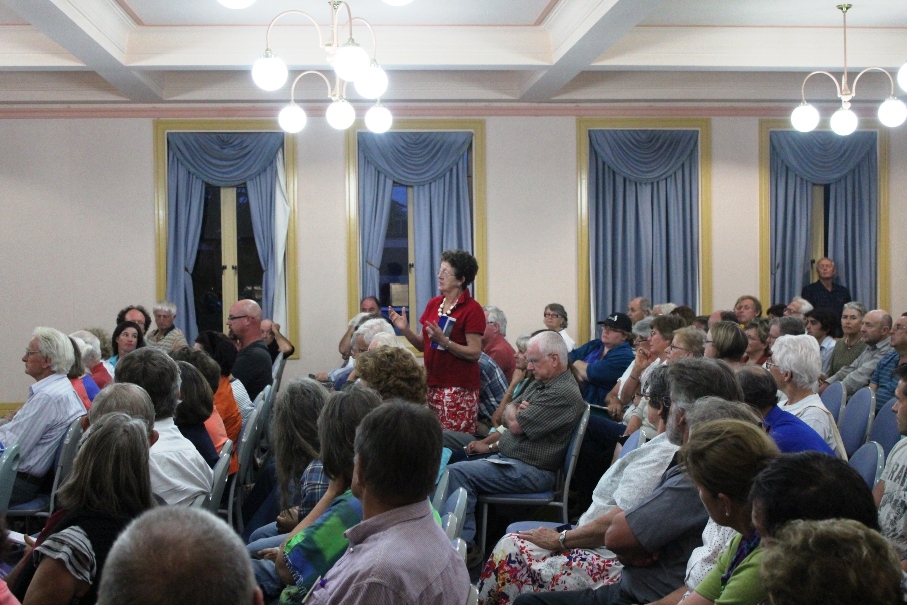 Community protest meeting against local coal mining
[Source: ‘Sea of hands support gasfield free region at Tamworth public meeting’, 20130226,
^http://maulescreek.org/news/page/3/] Community protest meeting against local coal mining
[Source: ‘Sea of hands support gasfield free region at Tamworth public meeting’, 20130226,
^http://maulescreek.org/news/page/3/]
.
[8] Whitehaven Coal – the dirty face of the Coal Industry

Whitehaven Jobs: << With a workforce which will surpass 1000 people in the next five years, we are the place for opportunity. We are independent, we have a high quality portfolio of producing mines and we are developing three of Australia’s most significant new coal projects.
We want smart, committed, motivated people who value a dynamic culture and quick decision making. We want people who value being part of a community and achieving goals. At Whitehaven people can make a difference, and do make a difference. Our operations are currently underpinned by our Narrabri underground longwall operation and our three existing open cut mines – all situated in NSW’s Gunnedah Basin.
Our Maules Creek Project, also in the Gunnedah Basin, was fully approved in July 2013 and will provide significant and exciting career opportunities across a wide range of mining-related professions. Maules Creek is one of the last major undeveloped and significant multi-seam coal deposits in New South Wales and is expected to sustain a potential project life in excess of 30 years. It is approved to extract up to 13 Mt of coal per annum and rail 12.4 Mt of product from the site in any calendar year.>>
[Source: <<http://www.whitehavencoal.com.au/careers.cfm]
.
[8] ‘Icons under threat‘, Nature Conservation Council of New South Wales, 2012, report, ^http://nccnsw.org.au/content/icons-under-threat
.
Saturday, October 5th, 2013
 ‘Typus Orbis Terrarum’ (Spherical Model of the Earth) of 1564
[Source: ‘World map showing the Great South Land, or ‘Terra Australis nondum cognita’, from Abraham Ortelius’ ‘Theatrum orbis terrarum’, No 41 Autumn 1988, The La Trobe Journal State Library of Victoria, State Government of Victoria Australia, ^http://www3.slv.vic.gov.au/latrobejournal/issue/latrobe-41/fig-latrobe-41P001a.html]
Click image to enlarge ‘Typus Orbis Terrarum’ (Spherical Model of the Earth) of 1564
[Source: ‘World map showing the Great South Land, or ‘Terra Australis nondum cognita’, from Abraham Ortelius’ ‘Theatrum orbis terrarum’, No 41 Autumn 1988, The La Trobe Journal State Library of Victoria, State Government of Victoria Australia, ^http://www3.slv.vic.gov.au/latrobejournal/issue/latrobe-41/fig-latrobe-41P001a.html]
Click image to enlarge
.
This is one of the earliest walled atlases of the world by Flemish cartographer and geographer, Abraham Ortelius (b.1527). Ortelius is generally recognized as the creator of the first modern atlas, here adopting the Theatrum Orbis Terrarum or “Theatre of the World” projected interpretation. Across the south of the world he extrapolated a then yet to be discovered ‘Terra Australis nondum cognita’ or Great South Land not yet known’.
Once known, it became abbreviated to ‘Terra Australis’ and subsequently named by British explorer Matthew Flinders’ simply as ‘Australia’. Since then Australians have abbreviated everything possible..
Ortelius is also believed to be the first to imagine that the continents were joined together before drifting to their present positions. So perhaps Ortelius should be a scholar of Gondwana.
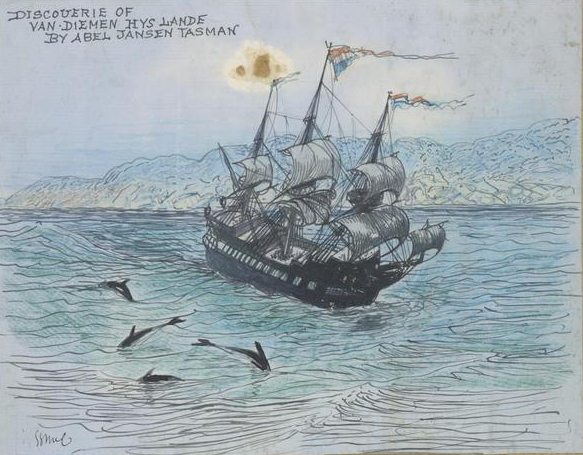 . .
The following extracts have been taken from the Introduction in a 1987 book by Ian G. Read entitled, ‘The Bush – a Guide to the Vegetated Landscapes of Australia‘.. Images have been added by our Editor.
<< Australia is a vast land of never-ending horizons, broken back ranges, eerily silent forests and golden, blue shores. It is also a land of vast suburban sprawls, monotonous cropping country, eroded hillsides and long lanes of traffic leading to the beach. It is a land that has been populated for millennia and a land that has attracted new populations to its more equable southern and eastern fringes. It is both an old and a new Australia.
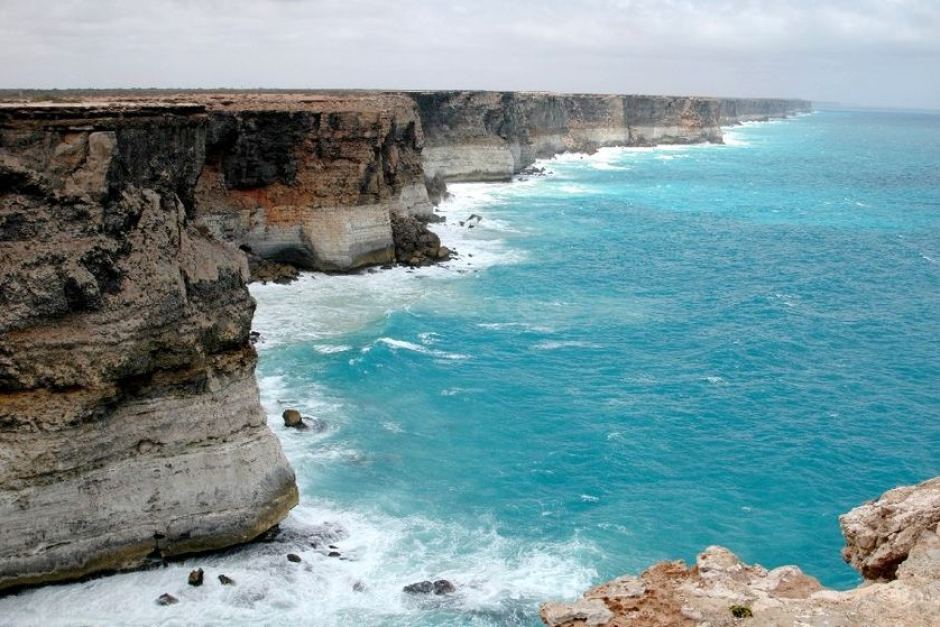 Perhaps each Australian would gain from pilgrimage to the infinite horizon of The Great Australian Bight,
to grasp its awe and so with it, their own smallness.
[Ed: Note the curvature of the horizon. The planet is not as unlimited as many babyboomers imagine.] Perhaps each Australian would gain from pilgrimage to the infinite horizon of The Great Australian Bight,
to grasp its awe and so with it, their own smallness.
[Ed: Note the curvature of the horizon. The planet is not as unlimited as many babyboomers imagine.]
.
To the European man Australia as firstly a mere conception, a conjecture on the earliest world maps, the Great South Land. With exploration and discovery the land grew in the minds of explorers, the map makers and the ruling classes of Europe. To Asian man Australia was a reality, particularly its northern shores which were frequently visited by peoples of the islands to the north. To the Aborigines Australia was home and has been for at least 40,000 years.
Europeans, being the latest of mankind’s races to make contact with Australia are, due to their history and traditions, the least capable of understanding the land. Having only settled here for seven or eight generations many European types have yet to establish a connection with the land beyond that of viewing the land as a resource. The last two hundred (and twenty five) years has seen the land undergo significant changes, the changes of occupation. No longer is the land in a state of balance but a state of change based on economic development.
.
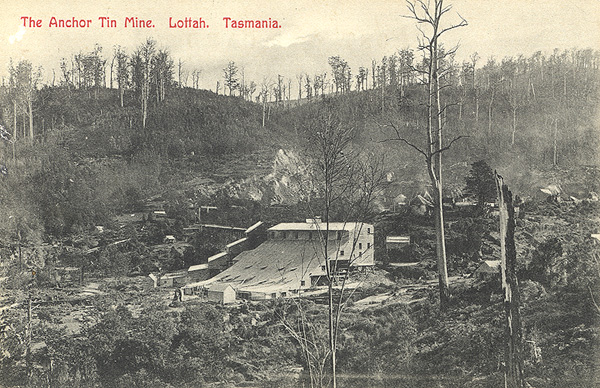 Anchor Tin Mine , Lottah Tasmania
(Tasmaniana Library, State Library of Tasmania) Anchor Tin Mine , Lottah Tasmania
(Tasmaniana Library, State Library of Tasmania)
.
As this development gained momentum during the twentieth century the new arrivals became less dependent on the land for their existence. There was a shift of values regarding the land; values which alienated the land further from the occupiers. European man did not see the land as nurturer but as a resource to be exploited. >>
.
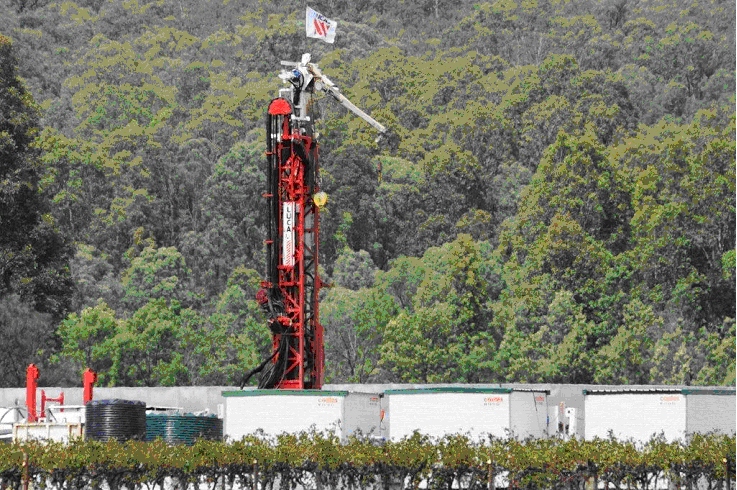 Coal Seam Gas Mining in the Hunter Valley north of Sydney, 2012
^http://www.huntervalleyprotectionalliance.com/HVPA_brochure_20120109.html Coal Seam Gas Mining in the Hunter Valley north of Sydney, 2012
^http://www.huntervalleyprotectionalliance.com/HVPA_brochure_20120109.html
.
<<..The history of European occupation of the lands of Australia is not a good one. Through fear, ignorance, greed or power much of the land has suffered. It is thought that the earliest settlers wanted to create landscape similar to where they came from so they imported planst and animals and a way of life in order to tame what they thought was a harsh environment.
.
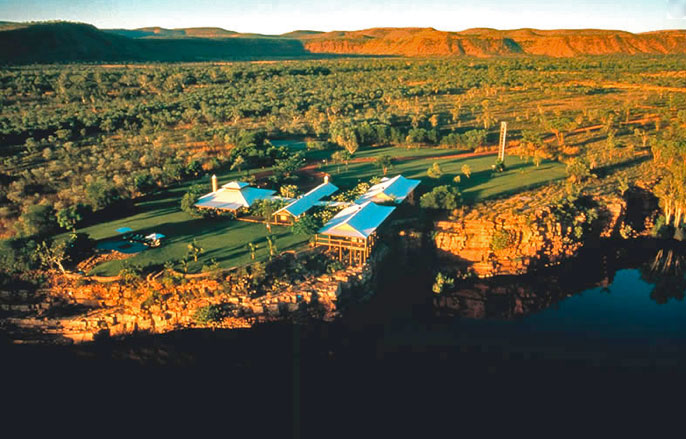 El Questro Station, The Kimberleys
Some things don’t change. The cattle station was initially established in 1903.
In 1991, an English aristocrat bought the cattle station and developed into a tourist park, and continues to run 8,000 head of cattle.
[Source: ^http://www.broomeandthekimberley.com.au/gibb-river-road-and-gorges/] El Questro Station, The Kimberleys
Some things don’t change. The cattle station was initially established in 1903.
In 1991, an English aristocrat bought the cattle station and developed into a tourist park, and continues to run 8,000 head of cattle.
[Source: ^http://www.broomeandthekimberley.com.au/gibb-river-road-and-gorges/]
.
The discovery of gold brought (considerably) more people who came to exploit the land without returning anything to it; needless to say many remained on the goldfields though most returned to coastal cities or to whence they came. Then followed a period of pastoral expansion whereby over ten per cent of the land was cleared of trees and another sixty per cent was grazed, browsed and trampled by sheep and cattle. Even today vast tracts of country are being cleared of vegetation.
.
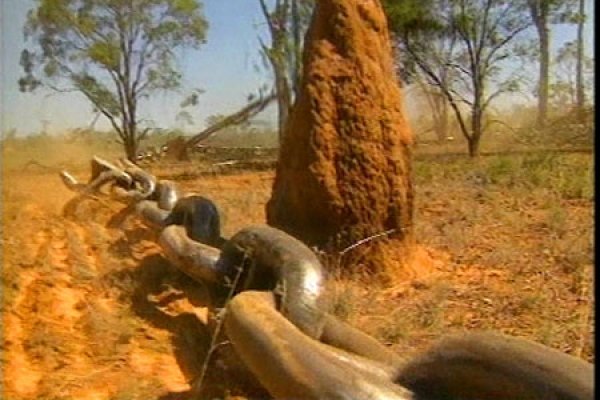 Queensland Premier Campbell Newman’s government this week passed the Vegetation Management Framework Amendment Bill, which effectively removes protection of two million hectares of mature and recovering bushland.
[Source: ‘Newman takes axe to Abbott’s Direct Action, and Qld bush’, 20130524, by Giles Parkinson, Australian and New Guinea Fishes Association – QLD Inc. ^http://www.angfaqld.org.au/aqp/blog/2013/05/24/newman-takes-axe-to-abbotts-direct-action-and-qld-bush/] Queensland Premier Campbell Newman’s government this week passed the Vegetation Management Framework Amendment Bill, which effectively removes protection of two million hectares of mature and recovering bushland.
[Source: ‘Newman takes axe to Abbott’s Direct Action, and Qld bush’, 20130524, by Giles Parkinson, Australian and New Guinea Fishes Association – QLD Inc. ^http://www.angfaqld.org.au/aqp/blog/2013/05/24/newman-takes-axe-to-abbotts-direct-action-and-qld-bush/]
.
Much of the Brigalow country of Queensland is disappearing; plans have been put forward to clear parts of the Western Division of New South Wales for crops while the conservative elements in Western Australia had plans to clear the Yilgarn and Dundas wilderness so that the sons of farmers could work their own properties. All this was (and is?) to occur in the face of unreliable rainfall, rising salt in the soil (which makes the land useless in less than three generations), and a loss of countless habitats.
.
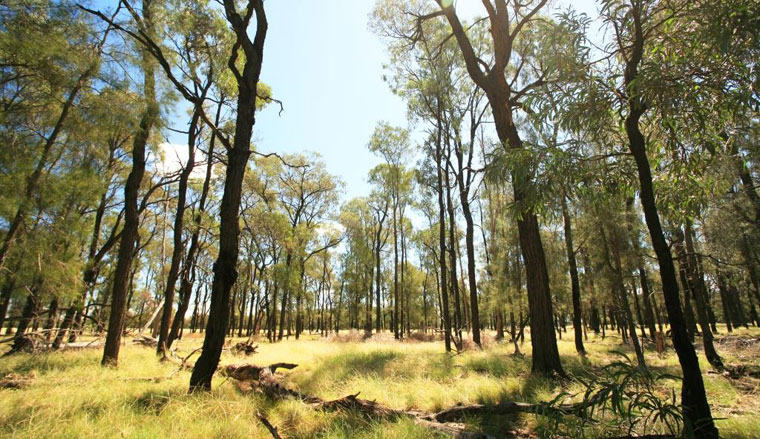 Brigalow Ecological Community (Acacia harpophylla) Brigalow Ecological Community (Acacia harpophylla)
Listed as Endangered in 2001 due to two centuries of continuing mass deforestation for cropping and pasture.
^http://www.environment.gov.au/cgi-bin/sprat/public/publicshowcommunity.pl?id=28&status=Endangered
.
Though fear of the land may have been reduced over the last two hundred (and twenty five) years ignorance, greed or power are still potent masters, and each still operates to alienate the European from his or her new landscapes.
The landscape does not evoke fear or alienation, the mind does. The landscape can trigger those feelings but it is the perception of that landscape through ignorance or a lack of understanding that induces a negative reaction.
Changing one’s perception requires more than changing one’s mind but it may be that understanding and interpreting what is being seen is all that is required. Interpretation need not be involved because all it requires is a knowledge of its components. It’s how these components fit together that is complicated. To be able to put a name to something greatly assists in interpreting what is being seen while to actually discover that named ‘something’ is an experience in itself. >>
.
~ Extracts from the Introduction, in The Bush – a Guide to the Vegetated Landscapes of Australia, by Ian G. Read, 1987, Reed Books, pp. 9-10.
.
Perceived character of natural areas (1978):
.
<<
- Less than 4% see natural areas as bad, ugly, noisy, dirty, repulsive, evil, wasteful, boring, dead, uninviting, dull, useless or depressing
- Between 4% and 25% see natural areas as bleak, dangerous or fragile
- Between 25% and 50% see natural areas as happy, friendly, sacred, huge, roadless or pure
- More than 50% see natural areas as good, remote, alive, exciting, unique, wild, challenging, inspiring, valuable, restful, unspoiled, free, beautiful or natural. >>
.
~ Based upon research for a doctoral thesis by Keith McKenry, contained in Mosley, 1978.
.
“Too far South for spices and too close to the rim of the earth to be inhabited by anything but freaks and monsters.”
.
~ Abel Tasman upon sighting the West Coast of Tasmania in November 1642.
.
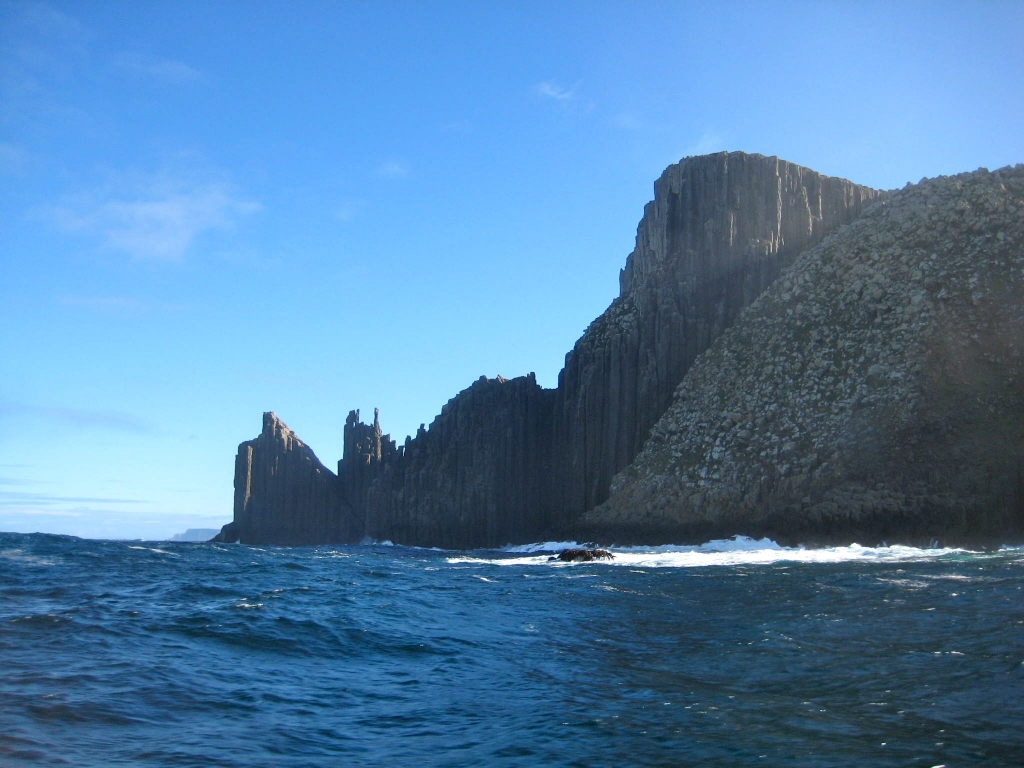 Photograph of Cape Point Raoul, South West Wilderness, Tasmania.
[Source: Jane Stadler, ^http://www.australian-cultural-atlas.info/CAA/listing.php?id=72] Photograph of Cape Point Raoul, South West Wilderness, Tasmania.
[Source: Jane Stadler, ^http://www.australian-cultural-atlas.info/CAA/listing.php?id=72]
.
<< Australia’s most important environmental case, ‘the Franklin Dams Case’, a successful High Court challenge, influenced the outcome of a federal election and resulted in World Heritage nomination for south-west Tasmania in 1982.
Enlarged in 1989 to cover 20 per cent of Tasmania’s land area, the Tasmanian Wilderness World Heritage Area (1.38 million hectares) failed to protect the tall eucalypt forests excluded by a convoluted eastern boundary. These ancient forests are being progressively decimated by industrial forestry, despite an international outcry. The south-west is recognised as one of the earth’s few remaining extensive temperate wilderness areas, a significant tourist drawcard posing fresh challenges as increasing visitor numbers impact on its outstanding natural values. >>
..
[Source: South West, by Helen Gee, 2006, in Companion to Tasmanian History, Centre for Tasmanian Historical Studies, University of Tasmania,^http://www.utas.edu.au/library/companion_to_tasmanian_history/S/South%20west.htm]
.
<< Overall, Australia has lost nearly 40% of its forests, but much of the remaining native vegetation is highly fragmented. As European colonists expanded in the late 18th and the early 19th centuries, deforestation occurred mainly on the most fertile soils nearest to the coast.
In the 1950s, south-western Western Australia was largely cleared for wheat production, subsequently leading to its designation as a Global Biodiversity Hotspot given its high number of endemic plant species and rapid clearing rates. Since the 1970s, the greatest rates of forest clearance have been in south-eastern Queensland and northern New South Wales, although Victoria is the most cleared state.
Today, degradation is occurring in the largely forested tropical north due to rapidly expanding invasive weed species and altered fire regimes. Without clear policies to regenerate degraded forests and protect existing tracts at a massive scale, Australia stands to lose a large proportion of its remaining endemic biodiversity. The most important implications of the degree to which Australian forests have disappeared or been degraded are that management must emphasize the maintenance of existing primary forest patches, as well as focus on the regeneration of matrix areas between fragments to increase native habitat area, connectivity and ecosystem functions. >>
.
[Source: ‘Little left to lose: deforestation and forest degradation in Australia since European colonization’, by Corey J. A. Bradshaw, School of Earth and Environmental Sciences, The University of Adelaide, article in Journal of Plant Ecology, Vol. 5, Issue 1, pp. 109-120, ^http://jpe.oxfordjournals.org/content/5/1/109.full]
.
.
.
Further Reading:
.
[1] ‘A Terrible Beauty‘, by Richard Flanagan, , Melbourne, 1985, Greenhouse Publications
.
[2] ‘The South West Book’, by Helen Gee & Janet Fenton,1978, Melbourne, William Collins and the Australian Conservation Foundation
.
[3] ‘Trampled Wilderness’, by R & K Gowlland, Devonport, 1975, C.L. Richmond and Sons Pty Ltd
.
[4] ‘History of West and South-West Tasmania’, by T Jetson & R Ely, Hobart, 1995, Tasmanian Historical Research Association
.
[5] ‘Patriots: Defending Australia’s Natural Heritage‘, by William J. Lines, 2006, University of Queensland Press
.
[6] ‘The Biggest Estate on Earth: How Aborigines Made Australia‘, by Bill Gammage, 2012, Allen & Unwin
.
[7] ‘Woodland to Weeds – Southern Queensland Brigalow Belt‘, by Nita C. Lester, 2008, 2 ed, Brisbane: Copyright Publishing
.
[8] ‘ The Discovery of Tasmania: Journal Extracts from the Expeditions of Abel Janszoon Tasman and Marc-Joseph Marion Dufresne, 1642 & 1772‘, rare book by Abel Tasman.
.
Wednesday, October 2nd, 2013
 An out of control petrol tanker semi-trailer speeding 80kph down Mona Vale Road rolls and explodes, burning two motorists to death. An out of control petrol tanker semi-trailer speeding 80kph down Mona Vale Road rolls and explodes, burning two motorists to death.
A further six people remain in hospital. The truck was carrying 18,000 litres of fuel when it rolled and erupted into a fireball. Mona Vale in is Sydney’s north.
[Source: The Daily Telegraph, 20131001, ^http://www.adelaidenow.com.au/news/driver-a-8216hero8217-after-runaway-tanker-explodes-in-mona-vale-victims-never-had-a-hope-witnesses-say/story-e6frea6u-1226730998888]
.
The cause is unknown at this stage, but it is the consequence that is the issue, irrespective.
Hardly a day goes past without some news story about a truck crash on a Sydney road and this is compounded across Australia.
Yet in transport policy unison, governments across Australia at state and federal levels have abandoned rail freight and instead are headlong encouraging more and bigger trucks on our roads. They are encouraging larger and long trucks and spending billions to accommodate them. Road making has become governments’ panacea for solving linehaul freight challenges. The numbers of trucks on local, suburban and regional roads across Australia must have doubled in the past decade or so.
At the same time, both levels of government have been lax for decades to ensure high standards of heavy vehicles and the professional competency of truck drivers. Australian trucking has become a cowboy game plagued by industry cost cutting and unreasonable delivery expectations. The industry’s problems compound down to the truckie.
Truck drivers across Australia are no longer paid a fair hourly rate for their work, but have been reduced to being paid by a minimalist ‘trip rate’. So the more trips they do, the more they get paid. Overnight linehaul trucking is a ticking time bomb.
Truck drivers across Australia more often than not are no longer paid employees who are professionally trained by their employers. They are typically owner driver sub contractors with a massive bank mortgage tied to the truck or prime mover they own. They only get paid by the runs they do and have all the burden of maintenance, repairs, insurance and loan repayments. That is before paying themselves a wage. Forget leave and superannuation.
Trucking industry professionalism is out the door. Anyone can get a truck licence. The concept of trucking being a profession in Australia in the days of TNT and Mayne Nickless has long become a distant memory. It is a mugs game now.
Truck drivers, motorists and roadside communities are the victims of dumbed down bad government transport policy. The only ones who are benefiting from cheap dumbed down trucking are the trucking magnates and their corporate retail clients. The politicians save money building trucking roads instead of big picture rail and integrated multimodal logistics. But roads for trucks is short term thinking. It is a policy that has ignored road users’ rights to expect the highest standards of road safety.
Australia’s trucking regime is sapping billions for faster and wider roads instead of long term investment in freight rail,just like their doing to the Great Western Highway to freight produce and goods across the continent. It’s to hell with the local communities they rip up along the way. It’s to hell with the native habitat they rip up to build wider and new trucking expressways. When fuel and toxic chemicals spill from overturned trucks, it’s to hell with the downstream environment.
More roadside communities are increasing exposed to the risk of deadly speeding trucks, and people are dying as a result.
.
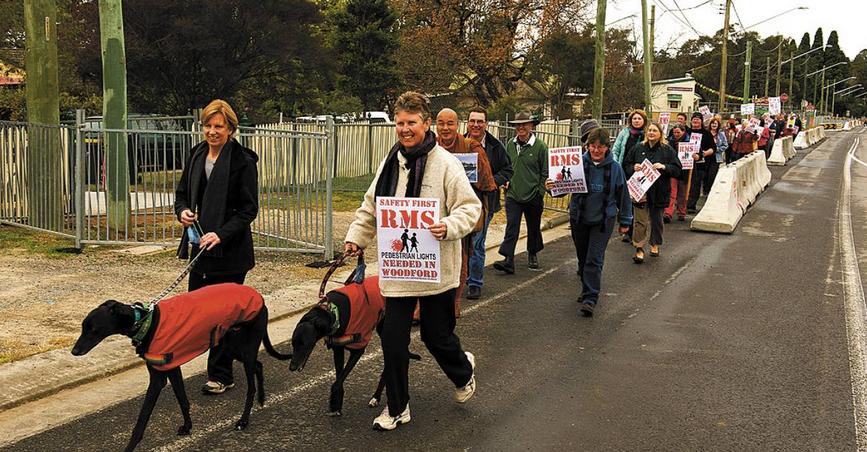 Safety First
Residents of the roadside community of Woodford in the Blue Mountains west of Sydney protest over losing their pedestrian crossing so that trucks can cruise nudging 90kph through their village. [Photo by Jodi McConaghy, 20130608] Safety First
Residents of the roadside community of Woodford in the Blue Mountains west of Sydney protest over losing their pedestrian crossing so that trucks can cruise nudging 90kph through their village. [Photo by Jodi McConaghy, 20130608]
.
The NSW Government’s RTA-come-RMS (roads authority) has “ripped the heart” out of Woodford.
Woodford Progress Association spokesman Ian Robinson told 100 residents in a protest rally last June that Woodford was “once known as the heart of the Mountains but the RMS has ripped the heart right out of our town”. Mr Robinson says the current plans leaves the elderly stranded, splits the town in two and forces school children to make a large detour to get to their bus stop, he said.
“Without lights across the highway within the vicinity of the Woodford Academy, not only children, but also residents and fire brigade volunteers on the north side are cut off from south side neighbours [and] the elderly … are stranded in their own village,” he said.
The truck-centric civil engineers with the RTA-come-RMS expect local residents to take a two kilometre detour to use the pedestrian bridge at Woodford railway station.
Mr Robinson said:
“They also now tell us that they do not regard Woodford as a ‘town’ and that they want to run four lanes of traffic at 80 km/hr right through the heart of Woodford.”
Cheap but dangerous seagull intersections are to be built in the centre of the new wider trucking expressway between massive trucks doing 90kph down the hill through Woodford.
A third resident petition to the NSW Roads Minister has again been ignored. It’s all about trucks with the politicians.
(Former) councillor Geordie Williamson, a Woodford resident, says the plan also threatens the lives of the 2500 Woodford residents.
“The very least RMS can do is grant residents a safe means of crossing the newly-widened highway. Failing to do so will virtually guarantee injury or loss of life in the years to come,” Clr Williamson said. “The highway should not only be designed to massage the bottom line of freight haulage companies.”
[Source: ‘Woodford fights for safer passage’, 20130620, by B. C Lewis, Blue Mountaisn Gazette, ^http://www.bluemountainsgazette.com.au/story/1585708/woodford-fights-for-safer-passage/]
.
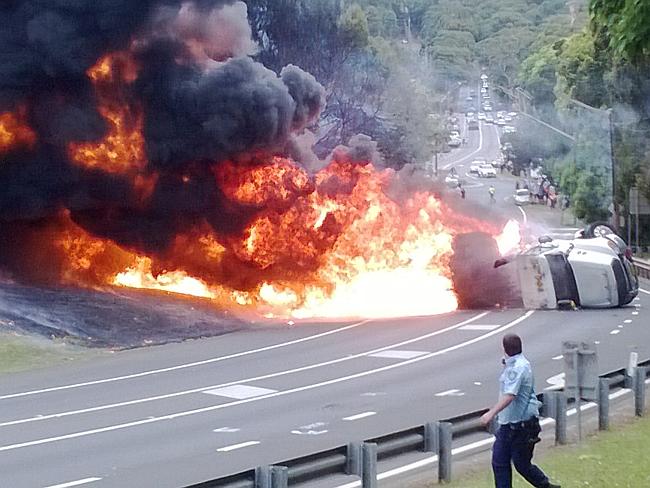 The Mona Vale Road trucking experience
Coming to a roadside community near you. The Mona Vale Road trucking experience
Coming to a roadside community near you.
.
Footnote
.
Government belatedly issues Cootes Transport with 126 Defect Notices
.
 . .
<< Police believe mechanical problems are the most likely cause of the fatal crash involving the Cootes Transport petrol tanker since the out-of-control fuel tanker ploughed into a power pole and four cars before erupting in a fireball on Mona Vale Road.
A Mr Shane Day has been identified as the driver of the petrol tanker, who works for Cootes Transport. It is not clear if he is an employee or a contractor, but industry probability would like be the latter and not paid by Cootes by the hour.
So two men were burnt alive when this Cootes petrol tanker lost control on Mona Vale Road at Mona Vale about 3:40pm (AEST) yesterday. Police say the dead men are a 71-year-old local and a man in his 60s from interstate. Both men were travelling in the same car, when this trucking wall of death bore down upon them.
Assistant Police Commissioner John Hartley:
“It certainly looks like they were killed at the scene by the fire rather than the crash itself.”
They were burnt alive.
Twelve trucks operated by Cootes Transport have been taken off the road. Inspectors from the New South Wales Government’s Roads and Maritime Services have subsequently inspected more than 80 Cootes Transport trucks at checking stations in Sydney and Newcastle late this afternoon. The company has been issued with 26 defect notices and 12 trucks have been taken off the road.
[Ed: A belated slap on the wrist for purported negligence causing two men to burn to death, just to pacify the media and political fallout. Government reactive and random monitoring of safety is negligent cost cutting and so life costing. At no time should unroadworthy trucks be in service. At no time should unprofessional heavy vehicle drivers be behind the wheel. It must cost more, and so be it. Next week as the media interest fades, it’ll be government trucking as usual and billion dollar truck magnate profit as usual].
.
Mr Hartley:
“We’re investigating a number of factors that may have contributed to the crash but at this stage we’re looking at the possibility of mechanical failure on the truck itself. That’s probably the most important lead we have at this stage. The vehicle needs to be fully examined properly. At the end of the day we’ll find that something quite simple such as mechanical failure or a mistake by the driver has caused these fatal consequences.”
.
Meanwhile, the toxic spill caused by a fuel tanker’s 18,000 litres of petrol from the exploded tanker has flooded and contaminated surrounding waterways and bushland.
A mix of fuel and fire retardant has leaked into the surrounding waterways for at least a 1.5 kilometre radius.
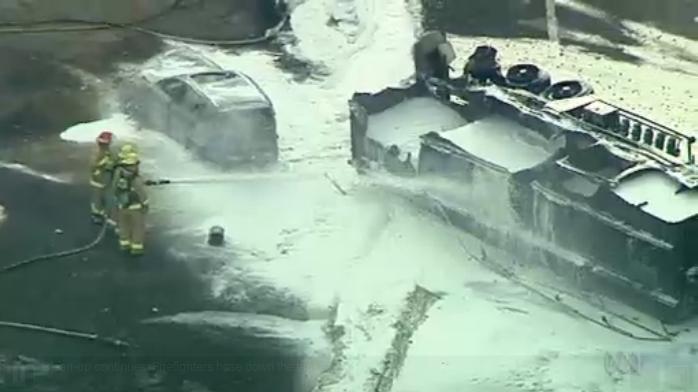 A toxic mix of 18,000 litres of petrol and fire retardant polluting surrounding waterways.
Without trucks Australia may stop, but with the current trucking mentality people are dying, like the two men burnt to death in the above car.
(Source: ABC News) A toxic mix of 18,000 litres of petrol and fire retardant polluting surrounding waterways.
Without trucks Australia may stop, but with the current trucking mentality people are dying, like the two men burnt to death in the above car.
(Source: ABC News)
.
NSW Fire Brigade Superintendent Ian Krimmer:
“It is a big operation to clean up the leaking fuel which has seeped into drains and waterways at Mona Vale. We’re placing sand in a number of those drains to contain the fuel spillage,” he said. It’s still unknown how much fuel has leaked into those drains. It could take several days to mop up and clean up that particular situation.”
.
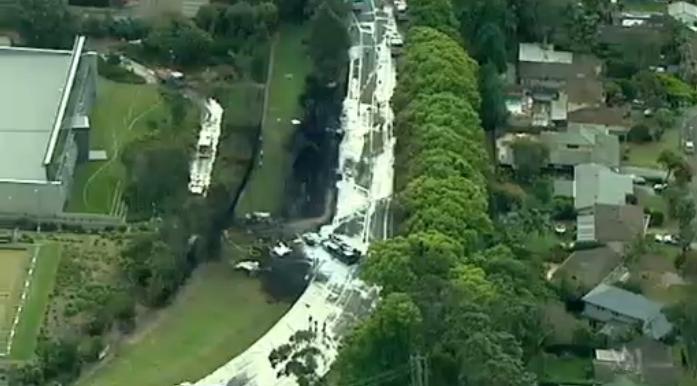 With Trucks Australia Stops With Trucks Australia Stops
.
[Sources: ‘Cootes trucks taken off the road after fatal tanker explosion in Mona Vale’, 20131002, ^http://www.abc.net.au/news/2013-10-02/mechanical-failure-suspected-cause-of-tanker-explosion/4994502; ‘Truck driver’s name revealed’, 20131004, ^http://www.dailyadvertiser.com.au/story/1819612/truck-drivers-name-revealed/?cs=332; ‘Toxic spill clean-up continues after fatal tanker crash at Mona Vale in Sydney’s north’, 20131002, ^http://www.abc.net.au/news/2013-10-01/two-dead-in-fuel-tanker-crash-in-sydney27s-north/4991974]
.
Tags: fuel and toxic chemicals, Great Western Highway, Mona Vale Road, overnight linehaul trucking, Petrol Tanker Crash, professional trucking, Roads and Maritime Services, RTA, RTA-come-RMS, speeding semi trailer, truck spills, trucking expressway, With Trucks Australia Stops, Without Trucks Australia Stops, Woodford pedestrian lights
Posted in Threats from Road Making | No Comments »
Add this post to Del.icio.us - Digg
|
|
 Ecological consultant David Paul with a koala found in the Leard State Forest
[Source: Photo by Tania Marshall, Front Line Action on Coal,
^http://frontlineaction.wordpress.com/]
Ecological consultant David Paul with a koala found in the Leard State Forest
[Source: Photo by Tania Marshall, Front Line Action on Coal,
^http://frontlineaction.wordpress.com/]
 Maules Creek Mine location map
[Source: Google Maps]
Maules Creek Mine location map
[Source: Google Maps]
 The Leard State Forest
An isolated remnant box woodland
The Leard State Forest
An isolated remnant box woodland
 Box Woodland decimated for industrial scale cotton
The farming model is entirely artificially dependent river-diverted irrigation for export produce.
[Source: Promotional tourism advertisement by the NSW Government,
^http://www.visitnsw.com/destinations/country-nsw/moree-and-narrabri-area/gallery]
Box Woodland decimated for industrial scale cotton
The farming model is entirely artificially dependent river-diverted irrigation for export produce.
[Source: Promotional tourism advertisement by the NSW Government,
^http://www.visitnsw.com/destinations/country-nsw/moree-and-narrabri-area/gallery]
 Leard State Forest location map
[Source: Google Maps]
Leard State Forest location map
[Source: Google Maps]
 Koala in Leard State Forest
[Source: Photo by Tania Marshall, Front Line Action on Coal,
^http://frontlineaction.wordpress.com/]
Koala in Leard State Forest
[Source: Photo by Tania Marshall, Front Line Action on Coal,
^http://frontlineaction.wordpress.com/]
 Nearby Boggabri Open Cut Coal Mine, owned by Whitehaven Coal
Saw thousands of hectares of native Box Woodland bulldozed in 2006.
Nearby Boggabri Open Cut Coal Mine, owned by Whitehaven Coal
Saw thousands of hectares of native Box Woodland bulldozed in 2006.
 (Click icon and play audio on the ABC Radio website, turn up volume to listen)
[Source: ‘Concern for Koala’s in the Leard State Forest’, 20121112, radio interview by Kelly Fuller, Morning Show, ABC Radio New England NSW,
^http://www.abc.net.au/local/audio/2012/11/12/3630754.htm]
(Click icon and play audio on the ABC Radio website, turn up volume to listen)
[Source: ‘Concern for Koala’s in the Leard State Forest’, 20121112, radio interview by Kelly Fuller, Morning Show, ABC Radio New England NSW,
^http://www.abc.net.au/local/audio/2012/11/12/3630754.htm]
 Community protest meeting against local coal mining
[Source: ‘Sea of hands support gasfield free region at Tamworth public meeting’, 20130226,
^http://maulescreek.org/news/page/3/]
Community protest meeting against local coal mining
[Source: ‘Sea of hands support gasfield free region at Tamworth public meeting’, 20130226,
^http://maulescreek.org/news/page/3/]


























